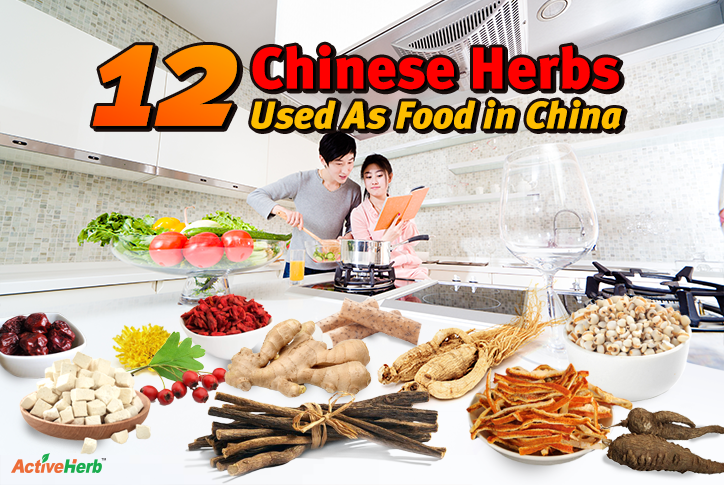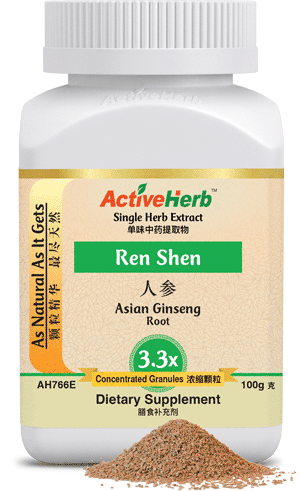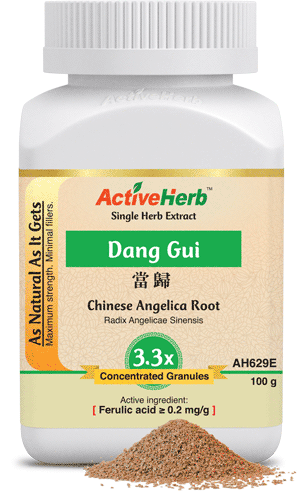12 Chinese Herbs Commonly Used as Food in China

Can you take medicine, and eat it, too? In China, there are 101 Chinese herbs officially designated as food items. Recently, we featured 7 common Chinese herbs that can be found in American kitchens.
This time around, let’s discover 12 common Chinese medicinal herbs used as food in Chinese kitchens (order at random).
#1: Gan Cao (Licorice Root)
In the U.S., most people associate licorice as a confectionary, best chewed on while watching a film at the movie theater. But, of course, this type of licorice is highly processed and loaded with added sugar. While licorice root certainly has sweet properties, according to TCM 5 Element theory, the sweetness (bittersweet, actually) in Gan Cao isn’t artificial. In fact, some herbalists recommend using it for preventing tooth decay.
In Chinese kitchens, Gan Cao is used in stews, soups and meat dishes. Therapeutically speaking, traditional licorice root is used for soothing belly aches, relieve loose stools, as well as coughing, and cramps.
Gan Cao, a heat-clearing herb, is ideal for digestive concerns because it tonifies the Spleen, the primary organ that transforms nutrients into Qi, according to TCM theory. In addition, licorice root relaxes spasms and soothes discomfort, which is why it’s a traditional herb for menstrual cycle support. In research studies, Gan Cao has been shown to support the immune system.
If you don’t plan on using Gan Cao in your recipes, you can benefit from this medicinal herb by easily making a tea with our extract granules.
#2: Da Zao (Chinese Date)
Chinese dates, like licorice root, benefit the Spleen system, thereby, improving digestion and building Qi. But perhaps its greatest therapeutic benefit is calming the Spirit. Indeed, research supports this traditional use, with a study published in Frontiers in Neuroscience, suggesting that when combined with the herb Gan Mai, Chinese dates have the potential to offer support in cases of occasional anxiousness.
Da Zao, also known as jujube fruit, is similar to Middle Eastern date varieties such as Medjool, in that they are sweet. According to TCM 5 Elements theory, Da Zao is warming by nature, thus this fruit features prominently in Chinese culinary winter dishes.
If you want the benefits of Chinese dates without the high amount of sugar contained in dried whole dates, you can drink Da Zao tea.
#3: Chen Pi (Dried Tangerine Peel)
Used as a seasoning in traditional Chinese cuisine, Chen Pi is yet another medicinal herb that tonifies the Spleen. In addition, it’s drying properties help transform excess phlegm (dampness) in the body, which is why this herb is an ingredient in our formula, Mucusolve. (So, too, is Gan Cao, as well as the next herb in this review of common medicinal foods in China.)
As for its potential benefits in research studies, Chen Pi has been shown to support cardiovascular function in animal models.
In cold weather months, you can help soothe your lungs by drinking Chen Pi tea. The easiest way to make it is with this granule extract.
#4: Fu Ling (Poria)
Fu Ling is a variety of mushroom. Although frequently used in Chinese cuisine, mushrooms have been receiving more attention in the West for their therapeutic benefits. Specifically, Fu Ling fungus promotes urination and leaches out dampness. Traditionally, it’s also used to calm the Heart, and, like the preceding herbs in this list, strengthen Spleen function.
In China, TCM doctors prescribe Fu Ling, or formulas containing it, for occasional sleeplessness and restlessness, as well as diarrhea and cardiovascular support.
But perhaps its most common use is for water-metabolism support. According to TCM theory, excess phlegm (dampness) accumulates first in the lower limbs, before moving up the body. Research studies have also focused attention on Fu Ling’s ability to support women’s reproductive health.
Don’t like sinking your teeth into mushrooms? You can still benefit from them by drinking Fu Ling tea, made with granule extract.
#5: Yi Yi Ren (Coix Seed)
Guess what one of the benefits of Yi Yi Ren is, from a TCM perspective? Need a hint? What’s the one trait that the preceding herbs share? That’s right, they all improve the function of the Spleen system.
Though coix seed isn’t common in American households, this dampness-removing herb (it also removes numbness, stops diarrhea, clears heat and expels pus), may one day become popular in the west. In fact, an article on BonAppetit.com predicts it will be the next cult grain, perhaps supplanting quinoa as America’s healthy grain of choice.
Also known as Job’s tears or Chinese pearl barley, Yi Yi Ren, like quinoa, possesses an Earthy taste with a chewy mouthfeel.
From a Western perspective, Yi Yi Ren offers antioxidant benefits, as it is rich in vitamin E.
If you’re trying to cut down on carbs or can’t easily find Chinese pearl barley, you can drink Coix Seed tea.
#6: Ren Shen (Ginseng)
Ginseng is one of the most common traditional herbs. It’s even a household name in the West, although in the U.S., it’s regarded as a supplement for treating colds. But in the Far East, ginseng is also a staple ingredient in numerous recipes.
In TCM applications, ginseng isn’t considered a cold remedy. Rather, its uses include tonifying Qi as well as the Spleen (of course!) and Lung meridians.
If you’re feeling feeble and don’t have much of an appetite, ginseng may help. Some people use it to support libido and sexual performance. Ginsenosides, the main active compound in ginseng, has been shown in research studies to support cardiovascular function, along with other positive outcomes.
Don’t plan on cooking with ginseng? No problem. You can make your own ginseng herbal tea, the easy way.
#7: Ju Hua (Chrysanthemum Flower)
Ever hear the expression, “mum’s the word,” meaning, be silent and don’t reveal the secret? Well, it turns out that chrysanthemum flowers, commonly known as mums in the west, do have a secret. Not only are these beautiful, bright-colored flowers a delight to behold, they also are considered a delicious, medicinal food in China.
The flowers are used in Chinese soups, stews, and other beverages, Ju Hua is also used in stir-frys, especially the young green leaves of the plant.
Ju Hua is in the category of Chinese herbs that clears heat. It also disperses wind, calms the Liver and improves vision. Its main active compound is Chlorogenic acid, which has been studied for its role in supporting a normal aging process.
In addition to decorating your home with mums, you can drink chrysanthemum flower tea.
#8: Shan Zha (Hawthorn Fruit)
According to Flavor and Fortune, a website dedicated to Chinese cuisine, hawthorn (or just “haw” for short) is used traditionally to benefit digestion and relieve diarrhea.
Another potential therapeutic benefit of Shan Zha is circulation support.
In Chinese cuisine, haw fruit is often made into wafers, which are used in stews and casserole dishes. If you’re watching your blood sugar, haw fruit can be used as a substitute for regular table sugar.
You can also support your circulatory system by drinking Shan Zha tea.
#9: Sheng Jiang (Fresh Ginger)
There is perhaps no other traditional herb that’s used in Chinese cooking more often than ginger. Virtually every stir-fry dish, dipping sauce and soup recipe calls for it.
If you’re constantly running cold and your skin is on the pale side, getting enough ginger in your diet can help warm your body up, due to its Yang-stimulating properties.
Ginger releases the exterior, which means it can help support your first lines of defense of the immune system. From a TCM perspective, ginger helps transform phlegm due to excess internal dampness.
Even if you’re already healthy, it’s a good idea to make sure you’re getting your daily dose of ginger to support your immune system.
Ginger is ideal in the winter as an ingredient in soup. But you can get the benefits of fresh ginger year-round, the easiest way, in the most concentrated form, by making a tea.
Just ½ gram (one-tenth of a teaspoon) of fresh ginger granules contains a 6X concentration of fresh ginger extract.
#10: Gou Qi Zi (Goji berries)
It seems that goji berries were added to the A-list of trendy superfoods in the West only within the last decade. However, goji berries (or “wolfberries” as they’re also known) have been consumed in China for at least 2000 years.
Marketed as an antioxidant-powerhouse in the West, in traditional Chinese medicine, Gou Qi Zi, nourishes and tonifies the Liver and Kidneys, which helps detoxify the system and prevent premature aging. In addition, the berries are used to support vision.
In the West, most people who buy goji berries eat them as a stand-alone snack, or in salads. In China, the berries are usually not eaten raw. Rather, they are cooked and featured in pork, chicken and veggie stir-frys. Goji berries are also an ingredient in tea.
Rather than buying expensive bags of goji berries, you can get the benefits from this superfood by making your own tea with goji berry extract granules. Just 2 grams per serving (approx. ½ teaspoon) is all it takes to get your daily dose of goji berries.
#11: Shan Yao (Wild Yam)
In traditional Chinese medicine, the underground stem of the veggie (the rhizome) is used to tonify the Spleen and nourish the Stomach, thereby improving digestion and balancing Qi. Also, wild yam is used to nourish the Lungs, generate fluids as well as benefit the Kidneys and prevent aging.
In the West, wild yam extract is used in bio-identical hormone therapy, and to support blood sugar levels.
Even on a hot summer day, you can get the benefits of wild yam by making an iced tea with Shan Yao granule extract.
#12: Dang Gui (Angelica Root)
We certainly didn’t pick Dang Gui last because it’s the least known of these dozen. In fact, it’s one of the most common medicinal herbs in Chinese medicine. Perhaps its most famous use is for encouraging normal, healthy menstrual cycles. Dang Gui nourishes and invigorates the blood, thereby helping to ease abdominal discomfort. There’s a good reason this herb is also commonly known as “Female ginseng.”
And if you’re having trouble with elimination, the properties of this herb, which is related to wild celery, moisten the intestines and moves the bowels.
The yellowish-brown root of the herb is used in several Chinese dishes, including Dang Gui chicken. You can get the benefits from Dang Gui by drinking it, instead of cooking with it.
Medicinal Herbs Used As Food In China: Conclusion
In the west, most people think of medicine as a man-made pill you swallow. But for thousands of years in China, herbs have been used—including as food—to clear blockages; nourish and strengthen organs that are depleted; dry or moisten tissues; and in general, promote Yin-Yang harmony.
May this article be a reminder that food can be used as medicine to achieve vitality and wellness. However, because of the pervasiveness of processed foods in the West, Yin-Yang balance can easily become disturbed, leading to symptoms. Traditional Chinese medicines, including herbs commonly used as food, may help restore your homeostasis.








